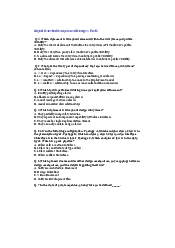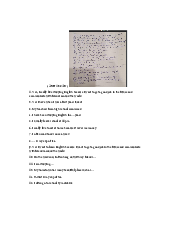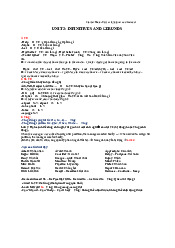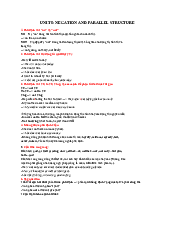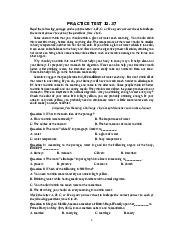








Preview text:
Vocabulary
1. Define foreign portfolio investment. How does it differ from foreign direct investment?
+ FPI refers to the investment in financial assets such as stocks and bonds of foreign
companies or governments, without obtaining significant control or influence over
the management of the invested entity.
+ The key differences between FPI and FDI:
2. Foreign direct investment decisions are normally based on clear business strategies.
Name at least three categories that companies are looking for. 1. Market Access:
Expanding into new and potentially lucrative markets
Gaining access to a larger customer base and increased sales potential
Bypassing trade barriers and tariffs
2. Resource Acquisition:
Accessing essential resources like raw materials, labor, or technology.
Reducing production costs and enhancing competitiveness.
Securing reliable and long-term resource supply
3. Strategic Advantages:
Building brand recognition and establishing a global presence
Acquiring knowledge and expertise through technology transfer or partnerships
Leveraging local capabilities and economies of scale
3. Give some examples of investment incentives. What are they supposed to achieve? 1. Tax Breaks:
Reduced corporate income tax rates: A lower tax burden directly increases a
company's profits, making the investment more attractive.
Tax holidays: A temporary exemption from paying taxes allows companies to focus
on establishing their operations without immediate financial pressure.
Exemptions from import duties: Lowering the cost of importing equipment and
materials reduces overall investment costs.
Attract businesses by decreasing their financial burden and boosting profitability. 2. Subsidies:
Direct financial grants: Cash injections provide immediate capital for companies to
invest in infrastructure, machinery, or research and development.
Matching grants: Governments can match a portion of a company's investment,
incentivizing them to commit more resources to the project.
Directly offset investment costs and make projects financially viable. 3. Infrastructure Development:
Government investment in improving roads, ports, and other infrastructure: Better
infrastructure reduces transportation costs, improves operational efficiency, and
makes the region more attractive to businesses.
Create a more accessible and business-friendly environment, attracting a wider range of investors.
4. What is non-exclusive distributor called? What does this mean?
A non-exclusive distributor is simply called "non-exclusive distributor". This means
they are authorized to sell a manufacturer's products but are not the only or sole
distributor in a particular territory. Key points to remember:
Non-exclusive distributors share distribution rights with other companies.
This allows manufacturers to reach a wider market and potentially increase sales.
It also increases competition and can lead to lower prices for consumers.
Exclusive distributors have sole rights to sell a manufacturer's products in a specific territory.
This gives them more control over the market and can lead to higher prices for consumers.
5. What are royalty payments?
Royalty payments are essentially fees paid by one party, called the licensee, to
another party, called the licensor, for the ongoing use of the licensor's intellectual
property or other intangible assets.
6. Define joint venture.
A joint venture is a business entity created by two or more parties, typically
companies, to collaborate on a specific project, venture, or market. It involves
shared ownership, shared resources, shared profits and losses, and shared governance.
FOREIGN DIRECT INVESTMENT
The decision to invest outside the home country is a major one that requires
careful analysis. Investments overseas can be portfolio investments, where investors
buy shares and debentures (long-term obligations) that can be liquidated at market
value any time. These investments can be made without leaving the home country
through an international investment broker or a banking institution. Foreign direct
investments are quite different. They usually involve the establishment of plants or
distribution networks abroad. Investors may acquire part or all of the equity of an
exciting foreign company with the objective of controlling or sharing control over
production, research and development, and sales. Contrary to portfolio investments,
foreign direct investments mean a long-term commitment where capital funds will be tied up for a long time.
Multinational corporation usually take a strategic approach is to locate or
create markets for its present and future products. Markets for products are no
longer national in today’s world. The technological and cultural changes of the
twentieth century and particularly in the three decades after World War II, have
created fairly uniform world markets, with increasingly similar economic and social
needs. All countries in the world strive to full technological growth and the highest
possible standard of living, regardless of their present stage of development.
Consequently, MNCs of all types and nationalities, large and small, have expanded
with great vitality abroad, often overshadowing their market shares at home. Such is
the case, for example, of the Swiss drug companies and the leading German,
Japanese, and American automobile manufacturers.
The typical MNC pools all its resources to achieve the highest possible
efficiency and obtain the maximum return on investments. Research and
development, raw materials, investment capital, and managerial skills are utilized
for the benefit of many world markets. For examples, an automobile originally
designed in Japan is later sold, assembled or manufactured, with minor changes, in
the United States, Canada, Brazil, Western Europe, and so on. The basis
development costs, like research and design, can be expected to be amortized on
sales in many markets. Research may be carried out in one country, parts made in
another, then assembled and sold in a third country.
Most American multinationals, already technologically advanced, do not have
to invest overseas to seek “know-how”. Many European and Japanese companies,
however, come to the United States to do just that. Their primary aim is to benefit
from American technology. For example, The British company, Plessey, made a
$190 million bid to take over American Alloys Unlimited, before the bid. Plessey
believed that it would be less costly to pay a higher price for technical “know-how”
than to do research and development in the alloy field over a period of time.
Financial considerations are also the most important and sometimes decisive
factors. What is the expected return on an investment? What are the sources of
working capital? What are interest rates? What is the cash flow projection? – i.e. the
amount of cash that remains after a company has paid taxes and other cash expenses?
Only when reliable access to outside financing is available can a project for foreign
direct investment be termed viable. A non-viable project is one where the expected
rate of return, or profits realized on assets employed, is likely to be lower than from
a comparable investment in the host country.
Local regulations or legislation is another factor that must be studied before an
investment is made. When Thomson, the French electronics group, set up a
company to produce military electronic devices in Chicago, it found out about the
Buy American Act only after the acquisition. This act prohibits the United States
government form purchasing foreign-made military equipment with the exception
of components. Subsequently, Thomson withdrew from the company at a
substantial loss. United States antitrust legislation prohibits corporations from
dominating or monopolizing an industry. When British Oxygen bought 35 percent
of Airco, a major United States producer of industrial gases, it was sued by the US
federal government for violating antitrust laws. Labor laws are still another
important legislative factor. Before an investment is made, it is important to
consider right-to-work laws and the existence of absence of labor unions.
The likelihood of government interference has to be studied. Despite France’s
efforts to attract foreign investment in the past companies to divest themselves of
their French subsidiaries. In 1976 International Telephone and Telegraph (ITT) sold
its interest in Le Matériel Téléphonique (producer of telephone equipment) to
Thomson, a French company, as a result of government pressure.
Investment incentives are still another consideration. These incentives are
usually of a monetary nature, such as cash grants, lower taxes, accelerated
depreciation, training allowances, research subsidiaries, and interest rebates on
loans. Incentives differ from country to country and region to region and are
always highest in a depressed area. In Belgium, where many coal mines have shut
down, certain regions experienced long periods of unemployment. These regions
are likely to offer incentives to foreign investors.
Prior to making a foreign investment, a corporation has usually had some form
of trade with the foreign nation. When a corporation starts to export for the first
time, it will usually engage distributors, who receive a commission on products
sold. Distributors are called exclusive if they are under contract to sell only the
exporter’s products. Otherwise, they are called multiple, representing other manufacturers as well.
When the foreign country becomes familiar with the products, the company
might not renew the contract with the distributors but rather will set up its own sales
organization. It will acquire its own network of dealers throughout the country,
probably supervised by various regional sales offices. Again, dealers can be exclusive or multiple.
Building up a dealer network is complicated and expensive. The exporter may
prefer to license a foreign manufacturer. The later is then authorized to manufacture
the product under license, using the original manufacturer’s brand name. In return,
the exporter will receive royalty payments. A drawback of licensing, as well as of
authorizing foreign distribution, is that the original manufacturer gives up control
over the product. If the licensed product lacks quality, the exporter’s reputation will
suffer. It may be very difficult to correct a distributor’s marketing mistakes if the
exporter eventually decided to handle the distribution.
Therefore, licensing and distributing are almost always of a temporary nature.
Sooner or later the exporter will be faced with the foreign direct investment
question. The basis decision is whether to set up a manufacturing plant or make an
acquisition of an existing one. Then there is the question of whether to create a joint
venture or go it alone. A joint venture is a subsidiary formed by two or more
corporations. This form is chosen when companies want to share capital outlay and
“know-how”. In the long run, it is often an unsatisfactory relationship, as the
respective partners find it increasingly difficult to share control. However, in some
countries, such as Japan and Spain, a foreign investor cannot own more than 50
percent of a corporation; that is, local interests in the foreign venture must equal at least 50 percent.
In many countries, especially in parts of the Third World, there is resistance to
foreign direct consequence of criticism of multinational corporations. In the
industrialized nations, such as France and the United States, opposition is also
growing. Even in some quarters in the United States, foreign investment is seen as a
threat. The critics forget, however, that their countrymen invested six times as much
overseas in 1976 as did foreigners in the United States.
Some strategic industries (such as food, computers, nuclear reactors, and
energy) will find it increasingly difficult to expand abroad. Foreign investment will
be dependent on the power struggle between governments and multinational
corporations. But direct investment is likely to continue its adventurous course in
many areas. The economic integration of the United States, Europe, and Japan will stimulate its development.
1. When foreign direst investors acquire a company, what do they normally seek to control?
Foreign direct investors normally seek to control:
Production: They aim to influence the process of manufacturing or assembling
products in the target country.
Research and development: They want to steer the research and development
activities related to the acquired company's products or services.
Sales: They desire to manage the distribution and marketing of the company's
offerings in the target market.
2. In considering foreign investment, what is an MNC’s first strategic objective?
An MNC's first strategic objective when considering foreign investment is to locate
or create markets for its present and future products. This means expanding their
customer base and ensuring long-term growth by entering new markets or
reinforcing their presence in existing ones.
3. What are some financial considerations in making a foreign direct investment?
Some financial considerations for FDI include:
Expected return on investment: The potential profit generated by the investment compared to other options.
Sources of working capital: Access to necessary funds to finance the investment.
Interest rates: Cost of borrowing money for the project.
Cash flow projection: Forecasting the available cash after all expenses are paid.
Availability of outside financing: Securing additional funding if needed.
4. When is a foreign project said to be viable? What is a nonviable project?
A foreign project is considered viable when the expected rate of return exceeds the
return on a comparable investment in the host country. It should also have reliable
access to funding and a positive cash flow projection. A non-viable project, on the
other hand, has a lower expected return than alternative investments or lacks financial feasibility.
5. Name two kinds of legislation that foreign investors study closely prior to making an investment?
Two types of legislation foreign investors closely examine before investing are:
Antitrust laws: Regulations prohibiting monopolies and ensuring fair competition within an industry.
Labor laws: Regulations concerning labor rights, unions, and working conditions in the host country.
6. Why are investment incentives highest in a depressed area?
Investment incentives are highest in depressed areas to attract foreign investors and
stimulate economic activity in those regions. These incentives typically offer
financial benefits like tax breaks, cash grants, or subsidized resources to make FDI more appealing.
7. When a corporation starts to export for the first time, how will it organize its sales?
Initially, a corporation likely relies on distributors to sell its products in the new
market. These distributors can be exclusive, representing only the exporter's
products, or multiple, handling various brands.
8. What is a drawback of licensing or authorizing foreign distribution?
A drawback of licensing or authorizing foreign distribution is the loss of control
over the product. The licensed manufacturer or distributor could compromise
product quality or make marketing mistakes that damage the exporter's reputation.
9. If a company does not want complete manufacturing responsibility for a foreign
market, what ownership possibility remains?
If a company doesn't want full manufacturing responsibility, it can consider a joint
venture. This involves partnering with another company, sharing manufacturing,
research and development, and other resources in the foreign market. While
sacrificing complete control, it reduces financial risk and potentially leverages the
partner's expertise and local presence. D. Exercises
Exercise 1: Fill in the blanks in the sentences below with the correct word or phrase.
1. When investors establish a plant overseas, this is called ………………… If they
buy shares or long-term debt obligations, this is called ……………
2. The amount of cash that remains after a company has paid taxes and other cash
expenses is ……………….
3. Rate of return is often measured in terms of profits realized on …………
4. A cash grant is called an ……………., whose purpose is to ………..
5. Prior to making a foreign direct investment, exporters can make a contract with a
……………. or with a foreign manufacturer, who will be
.................................................................................................................................... to manufacture their products. For this, the foreign manufacturer pays ………………….
1. Foreign direct investment (FDI), portfolio investment 2. Cash flow 3. Assets employed
4. Incentive, attract foreign investors
5. Distributor, licensed, authorized, royalty payments
Exercise 2: Complete this passage by using the word in italics. attitude
equity incentives investors levels prosperity dominate
employ train set up bring out
Countries in the Third World have different approaches to foreign investment.
Some welcome foreign firms, encouraging them to (1) foreign investment
subsidiaries by offering them tax (2) incentives or cheap loans. These countries believe that the
foreign firms will provide jobs, pay good wages, (3) train local workers,
bring new technology, and contribute to their (4) prosperity
Other countries have a different (5) attitude to foreign investment. They know
that they need the multinationals, but they do not want these firms (6) to dominate
important sectors of their economies. Therefore, they (7) pass laws which
force foreign companies to sell shares to local (8) investors. They insist that local
businessmen own a certain percentage of the foreign firm’s (9) equity Some .
governments also make the foreign firm (10) employ a certain percentage of local
workers at all (11) levels in the company.
Exercise 3: Find an appropriate word for each blank space. In all sections
the initial letter of each word is provided.
a) Most multinational companies are vast enterprises with networks of (1)
s………………… or (2) a……………… throughout the world. Originally, they
expanded overseas because trade barriers such as (3) t……………… and (4)
q…................had been set up against their goods.
b) When incomes are rising and business is thriving, in other words, when there is an
(5) e………………. (6) b…………….. in a country, a multinational may decide to
establish a subsidiary there. Later, however, the government of the country may
only allow the company to operate on a (7) j………………. (8) v……………..
basis, in which case it will compel the company to reduce its (9) s………………. to
a fixed percentage. It could even restrict the subsidiary by allowing only a fixed
proportion of profits to be (10)r……………….
c) The OECD code gave (11) g…..........................on how multinationals should behave.
None of its provisions were (12)l………………. (13) e……………… and
therefore some say it lacked legal teeth.
d) A factory whose production resources are not being fully utilized is said to
be suffered from (14) o……………… a) (1) subsidiaries (2) affiliates (3) tariffs (4) quotas b) (5) economic boom (6) prosperity (7) joint venture (8) basis (9) stake (10) repatriated c) (11) guidelines (12) legally binding (13) enforceable d) (14) overcapacity
Exercise 4: Picture yourself as a corporation president who is about to decide
on making a foreign direct investment. What questions would you ask yourself? Market and Opportunity:
1. Which new market(s) offer the most promising opportunity for our products or services?
2. What are the potential demand dynamics and growth projections in this market?
3. Do we face any unique cultural, social, or legal barriers in this market?
4. Who are our main competitors in this market, and what are their strengths and weaknesses? Financial Feasibility:
5. What is the expected return on investment (ROI) for this project?
6. What are the estimated start-up and operational costs?
7. Are there any available government incentives or tax breaks in the target country?
8. How will we secure funding for this project?
9. What are the potential currency exchange risks and fluctuations? Operational Considerations:
10. What entry mode should we choose: greenfield investment, acquisition, joint venture, or licensing?
11. What kind of infrastructure and supply chain is available in the target market?
12. How will we recruit and manage skilled employees in a new country?
13. What are the local labor laws and regulations regarding working conditions and benefits?
14. How will we ensure compliance with environmental and sustainability regulations? Risk Management:
15. What are the political and economic risks in the target country?
16. What are the potential intellectual property risks involved in this project?
17. How will we mitigate the risk of corruption or bribery in the target country?
18. Have we prepared contingency plans for unforeseen challenges or disruptions?
19. What kind of exit strategy do we have in place if the project is unsuccessful? Long-Term Vision:
20. How does this foreign investment align with our company's overall strategic goals and vision?
21. What are the potential long-term benefits for our company, employees, and stakeholders?
22. How will this investment contribute to the sustainable development of the target country?
